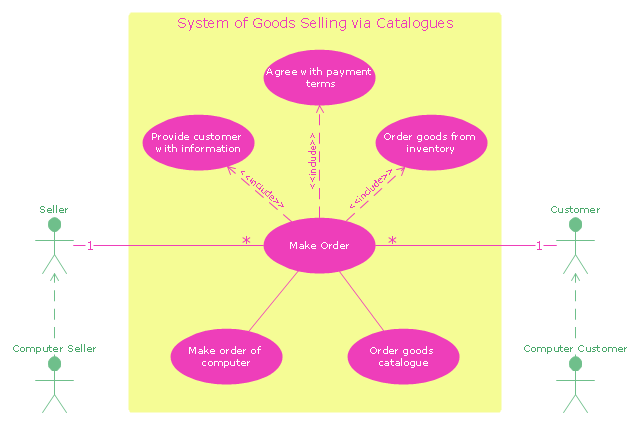"A catalog merchant (catalogue merchant in British and Canadian English) is a form of retailing. The typical merchant sells a wide variety of household and personal products, with many emphasizing jewelry. Unlike a self-serve retail store, most of the items are not displayed; customers select the products from printed catalogs in the store and fill out an order form. The order is brought to the sales counter, where a clerk retrieves the items from the warehouse area to a payment and checkout station. ...
The catalog merchant has generally lower prices than other retailers and lower overhead expenses due to the smaller size of store and lack of large showroom space.
There are a few key benefits to this approach. By operating as an in-store catalog sales center, it could be exempt from the "Resale price maintenance" policy of the manufacturers, which can force conventional retailers to charge a minimum sales price to prevent price-cutting competition; it also reduces the risk of merchandise theft, known in the industry as shrinkage.
From the consumer's point of view, there are potential advantages and disadvantages. The catalog showroom approach allows customers to shop without having to carry their purchases throughout the store as they shop. Possible downsides include that customers may be required to give their contact information when an order is placed, take the time to fill out order forms, and wait a period of time for their order to be available for purchase. This wait may be days long, one of the chief vulnerabilities of the catalog showroom approach." [Catalog merchant. Wikipedia]
The UML use case diagram example "System of goods selling via catalogues" was created using the ConceptDraw PRO diagramming and vector drawing software extended with the Rapid UML solution from the Software Development area of ConceptDraw Solution Park.
The catalog merchant has generally lower prices than other retailers and lower overhead expenses due to the smaller size of store and lack of large showroom space.
There are a few key benefits to this approach. By operating as an in-store catalog sales center, it could be exempt from the "Resale price maintenance" policy of the manufacturers, which can force conventional retailers to charge a minimum sales price to prevent price-cutting competition; it also reduces the risk of merchandise theft, known in the industry as shrinkage.
From the consumer's point of view, there are potential advantages and disadvantages. The catalog showroom approach allows customers to shop without having to carry their purchases throughout the store as they shop. Possible downsides include that customers may be required to give their contact information when an order is placed, take the time to fill out order forms, and wait a period of time for their order to be available for purchase. This wait may be days long, one of the chief vulnerabilities of the catalog showroom approach." [Catalog merchant. Wikipedia]
The UML use case diagram example "System of goods selling via catalogues" was created using the ConceptDraw PRO diagramming and vector drawing software extended with the Rapid UML solution from the Software Development area of ConceptDraw Solution Park.
 Aerospace and Transport
Aerospace and Transport
This solution extends ConceptDraw PRO software with templates, samples and library of vector clipart for drawing the Aerospace and Transport Illustrations. It contains clipart of aerospace objects and transportation vehicles, office buildings and anci
 Spatial Infographics
Spatial Infographics
Spatial infographics solution extends ConceptDraw PRO software with infographic samples, map templates and vector stencils libraries with design elements for drawing spatial information graphics.
- Taxi Service Data Flow Diagram DFD Example | UML Use Case ...
- Use Case Diagrams technology with ConceptDraw PRO | UML ...
- UML Use Case Diagram Example Registration System
- UML use case diagram - System of goods selling via catalogues ...
- UML Use Case Diagram Example - Estate Agency | Work Order ...
- UML Use Case Diagram Example Registration System
- Computer and Networks Area | UML use case diagram - System of ...
- UML Tool & UML Diagram Examples | UML Diagram | UML use ...
- UML Use Case Diagrams | Entity-Relationship Diagram (ERD ...
- Software development with ConceptDraw Products | UML use case ...
- Block diagram - Selling technology patent process | UML use case ...
- Block Diagrams | Basic Diagramming | UML Block Diagram | Block ...
- Use Case Diagrams technology with ConceptDraw PRO | UML Use ...
- Design elements - UML use case diagrams | UML Sequence ...
- UML Notation | UML Diagram Types List | UML Diagramming ...
- UML Class Diagram Example for Transport System
- Parking and roads - Vector stencils library | Site accessories - Vector ...
- Block diagram - Automotive HVAC system | Functional Block ...
- UML Diagram | UML Activity Diagram. Design Elements | UML ...
- UML Component Diagram Example - Online Shopping | Design ...
